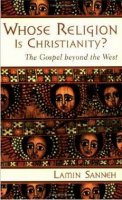In this brief book, Lamin Sanneh alerts the “post-Christian West” to the reality of “post-Western Christianity” (83). Written mostly in the form of an imagined dialogue to answer one hundred and fifteen enumerated questions, the manuscript bears witness to the universal relevance and applicability of the gospel message. Sanneh points out the worldwide indigenous appropriation of the Christian scriptures that has happened often beyond the reach and support of western institutions. He lauds the societal benefits that have resulted. Whose Religion? is a concise presentation of the cultural translatability, historical persistence, and contemporary vitality of the Christian faith. Sanneh both predicts and encourages the renewal of the western church by an encounter with world Christianity. With this treatise he introduces readers, in a playful, somewhat redundant yet poignant manner, to certain important aspects of the larger global context in which we find ourselves as well as to several specific controversial assertions. The book is an accessible primer on the more scholarly work and growing literary corpus of Sanneh, a Gambian, and the D. Willis James Professor of Missions and World Christianity at Yale Divinity School and Professor of History at Yale University.
Reading Whose Religion? helped me feel and appreciate the divinely orchestrated, central place of the gospel’s transmission – and appropriation – in the course of world history and current events. Sanneh’s differentiation between indigenous, pluriform “world Christianity” and western, hegemonic “global Christianity” (22-23, 55, 78, 85) is a distinction that facilitated this visceral perception, though his choice of contrastive terms seems arbitrary rather than reasoned convincingly. His polemic engagement with the narrow assumptions of western secularism highlighted afresh the growing divergence between my own Christian faith and my traditional cultural context; it also reminded me of the growing moral divide between my own cultural setting and that of all persons in the more pervasively religious majority world. Sanneh’s commendation of the church as a space for personal healing (33) and a force for societal impact (81, 99, 104) renewed my appreciation for the vast implications of participation in Christ’s kingdom. Sanneh’s optimism regarding the more attractive nature in Africa of an indigenized Christianity over against a culturally colonizing Islam fueled my hope for the church’s expansion in religiously contested places on that continent. For more on the topic of Islam and Christian conversion in sub-Saharan Africa, I highly recommend Sanneh’s account of his own childhood and conversion process in his recent autobiography, Summoned from the Margin: Homecoming of an African (Eerdmans, 2012). That beautifully written memoir is a poetic elaboration upon and personal illustration of so much of what he asserts in Whose Religion?
Sanneh is at his best, and most controversial, when he discusses what he calls the translatability of Christianity. To say that Bible translation is possible because “languages are not mutually exclusive” (127) is a wonderful indication of the universality of humankind in the image of a triune and communicative God. To say that translation is “the church’s birthmark and its missionary benchmark” (97) is a great way to remind readers of both the obligation and possibilities of translating the message again and again, for others as well as for oneself. Because God’s place in the Bible is central, translation is essential to maintain his central place in the message conveyed and in each culturally manifested expression of Christianity (105). However, Sanneh reaches too far in celebrating continuity between African religions and the gospel message per se rather than between African culture and biblical faith expressed or embedded in it (18, cf. 32, 42-43). The unfortunate influence of von Harnack and Ritschl on Sanneh’s theological perspective and interpretation of contextualization is made explicit in his now classic apologetic, Translating the Message: The Missionary Impact on Culture (Orbis, 2009; original 1989).
Despite not insignificant deficiencies in Sanney’s theology of history and theology of non-Christian religion(s), the reader will find Whose Religion? to be a stimulating guide in thinking through some reasons Christianity is a world religion today, why it flourishes where it does, and how to bring this information to bear on the objections of the skeptics we meet, be they Muslim or militantly secularist.
